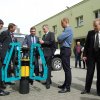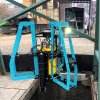 |
 |
On the 11th of April this year, a conference was held at the Central Mining Institute for project STAMS, short for: “Long-term stability assessment and monitoring of flooded shafts”, the realisation of which is co-financed by the European Research Fund for Coal and Steel as well as the Polish Ministry of Science and Higher Education, under national funds for research activities.
The STAMS project is focused on issues connected with the stability monitoring and assessment of partially or fully flooded mine shafts. Since the hard coal mining sector in the European Union is currently undergoing significant restructuring, there are an increasing number of mine shafts that are closed down or earmarked for closure, which is why research such as this is particularly important. The project is realised by an international consortium composed of representatives of universities, research bodies and industrial partners from Poland, Spain, Germany, France and the United Kingdom.
“The participation of four specific industrial partners is especially important for the project – two coal producers, i.e.: Polska Grupa Górnicza S.A. from Poland and Hulleras del Norte HUNOSA from Spain, and two partners involved in the restructuring of mines and the management of their assets after closure – i.e.: Spółka Restrukturyzacji Kopalń S.A. from Poland and Coal Authority from the United Kingdom,” states Zbigniew Lubosik, D.Sc. Eng., project director and GIG Deputy General Director for Geoengineering and Industrial Safety. Currently, there are sixteen partially or fully flooded shafts located in urban areas in Poland. Dangerous consequences may arise should their lining lose stability, such as the flooding of adjacent mines, shafts or even low-lying urban areas. Apart from disturbances to hydrogeological conditions, other results may also include damage to the technical infrastructure in the area of the shaft. Due to technical limitations, no studies of shaft lining in flooded sections have hitherto been conducted in Poland. The participation and commitment of mining companies proves that the realisation of the project is necessary, while its results will find practical application and benefit the industry.
Among the tasks undertaken by the project, a new probe has been designed, which can be used to determine the technical status of the shaft lining in flooded sections, which has thus far constituted a major problem. The device is adapted for work in high-pressure conditions and has undergone successful tests in flooded shafts. Utilising the probe makes it possible to collect a series of data, which enable the preparation of reliable numerical models and, consequently, the long-term stability assessment of flooded mine shafts.








